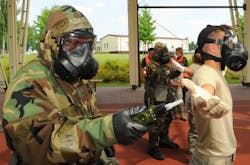Army set to kick off JBSDS 2 program to detect, track and analyze clouds of biological warfare agents
NATICK, Mass., 4 March 2011. U.S. Army researchers are ready to kick off the Joint Biological Standoff Detection System, Increment 2 (JBSDS 2) program to develop and mature biological detection prototype systems able to provide standoff detection, tracking, and discrimination of biological warfare agent clouds.Officials of the Army Natick Contracting Division of the Army Contracting Center in Natick, Mass., say they expect to issue a request for proposals (RFP) by the end of this month for the initial phase of the JBSDS 2 program.The Natick Contracting Division will issue the JBSDS 2 RFP on behalf of the Joint Project Manager-Biological Defense (JPM-BD) in Falls Church, Va. Army officials say they expect to award as many as three contracts for the first phase of the JBSDS 2, which is to develop prototypes of standoff biological agent detection and discrimination hardware and software, as well as testing at several locations.
The second phase of the JBSDS 2 program, which will involve a second RFP, will be for full-scale development and low-rate initial production of the JBSDS 2 system.
Biological agents can include any organism or poison found in nature that can be used to incapacitate, kill, or otherwise impede an enemy. Biological weapons are characterized by low visibility, high potency, substantial accessibility, and relatively easy delivery.
Biological agents can include viral agents that induce sicknesses such as smallpox, viral encephalitides, viral hemorrhagic fevers; bacterial pathogens such as anthrax, brucellosis, plague, tularemia, and Q fever; or viral toxins, which are poisons derived from plants and fungi. These can include staphylococcal enterotoxin B, ricin, botulinum toxin, and mycotoxins.
When released, anyone interested can see the solicitation online at www3.natick.army.mil/busopps.html, or at www.jpeocbd.osd.mil. Army officials caution that they will not issue a paper RFP for the program.
For questions or concerns about the JBSDS 2 program, contact Richard Totten of the U.S. Chemical Biological Medical Systems Joint Project Management Office in Frederick, Md., by phone at 301-619-2446, by e-mail at [email protected], by fax at 301-619-5069, or by post care of CBMS-JPMO, Attn: JBSDS2, 64 Thomas Johnson Dr., Frederick, MD 21702-5014.
To inquire about the upcoming JBSDS 2 program RFP write to the contracting office at RDECOM Contracting Center - Natick R&D (RDECOM-CC), ATTN: AMSRD-ACC-N, Natick Contracting Division (R and BaseOPS), Building 1, Kansas St., Natick, MA 01760-5011. Refer to RFP number W911QY-11-R-0019 in written correspondence.
More information is online at http://www.fbodaily.com/archive/2011/03-March/05-Mar-2011/FBO-02392454.htm.
For more information contact the Army's Natick Contracting Division online at www3.natick.army.mil, the Joint Project Manager-Biological Defense at www.jpeocbd.osd.mil, or the U.S. Chemical Biological Medical Systems Joint Project Management Office at www.jpeocbd.osd.mil.

